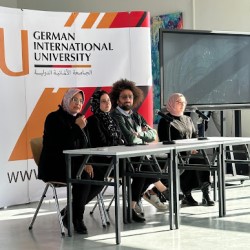 As a lecturer at the German International University (GIU) at the faculty of Informatics and Computer Science, Nada Sharaf has always been fascinated by how technology can affect and transform the educational experience for both students and educators. And with the use of augmented, virtual and mixed reality (AR/VR/MR) continuing to grow in Egypt, Sharaf has focused his work on investigating how these technologies can be successfully deployed in education.
As a lecturer at the German International University (GIU) at the faculty of Informatics and Computer Science, Nada Sharaf has always been fascinated by how technology can affect and transform the educational experience for both students and educators. And with the use of augmented, virtual and mixed reality (AR/VR/MR) continuing to grow in Egypt, Sharaf has focused his work on investigating how these technologies can be successfully deployed in education.
Most recently, with the support of an Emerging Technology Fund grant from the IEEE Computer Society, Sharaf facilitated a symposium called Exeed, at which AR/VR/MR experts shared their experiences and helped motivate student participants to use these tools in education in Egypt.
A panel of technology and education experts
Speaking to a diverse audience of students, Exceed hosted speakers, including:
- Slim Abdennadher, German International University President
Abdennadher welcomed event participants and introduced them to the importance of integrating technology in education, especially virtual and augmented reality. He also presented some of the previous work done by GIU researchers in this field.
- Kay Berkling, Professor, DHBW Mosbach (Germany)
Berkling’s talk was entitled “Combining Technology and Education.” Berkling introduced the audience to the existing and emerging trends in digitizing education, including extended realities, nano-credentials, and online/hybrid study programs after Covid.
- Mohammed RizkAllah, Ph.D. in Stem Education, CEO of Explore Agora
RizkAllah discussed the journey of Explore Agora. He is a firm believer in the importance of hands-on learning and believes augmented reality and computer vision help facilitate knowledge in his presentation. RizkAllah motivated participants to explore building more informative and effective platforms through augmented and virtual reality technologies.
- Franziska Englberger, Digital Fashion Instructor at the German International University
In her talk, “Digitizing Fashion Education,” Franziska introduced the audience to how technologies such as augmented and virtual reality benefit the fashion industry and the fashion design process.
- Maha El-Gewely, a lecturer in the Architecture Engineering program
El-Gewely spoke on the use of virtual reality for education in architecture.
- Amany Elfar, head of Nile Schools in Egypt
Under Elfar’s leadership, the Nile Schools are in the process of establishing VR/AR/MR labs to teach students about different concepts using new technologies.
Successful Interactions
During presentations and discussions, student participants were able to interact directly with the panelists. This engendered thoughtful questions about making AR/VR/MR in education successful, practical, and applicable.
“After the event, students expressed how grateful they were to participate and how fun Exeed was for them. Many want to continue working in this direction,” said Sharaf.
In addition to learning from expert speakers, students participated in a hackathon during the event: They implemented solutions that utilize AR/VR/MR for education. A total of 12 teams of undergraduate students attended introductory programming sessions, leaned on the GIU team and experts to formulate prototype ideas, and then worked in the GIU labs to implement and test their solutions over the course of three days. This approach created an invaluable, hands-on learning experience.
Next Steps
Following this event, work continued for Sharaf and his colleagues. In fact, he is currently collaborating with Englberger to build immersive, interactive displays with digital fashion garments. In addition, information from Exeed is being used to help develop labs that are being established in Nile Schools. And finally, Sharaf is working with RizkAllah on ways to achieve efficient and effective AR educational experiences for students.
But the event did not impact subject-matter experts alone. Participating students embraced their exposure to AR/VR/MR in education, and now, they are active participants in the aforementioned projects that support use of these technologies in educational environments.
“A major success factor of Exeed is that the students working on these [new] projects are participants who learned about the technology through the introductory sessions held during the event,” summed up Sharaf.